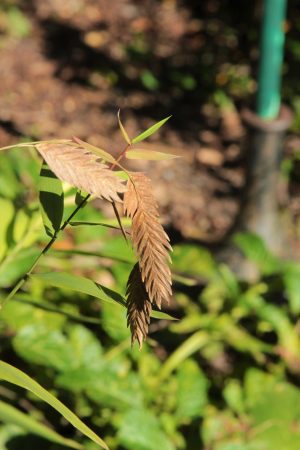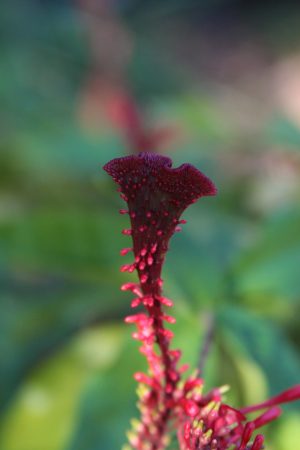“It’s funny, I spend some time out here doing things that I need to do,” Virginia Overstreet says in her Sylvania, Georgia accent, “Then I’ll come out here with no to-do list and before I know it I’ll spend 3 hours and it will have been all productive.”
Overstreet, who reached Master Gardner emeritus status a few years ago, has lived at her Seminole Heights, Tampa home since 1998. After 20 years in the Navy she retired in 2000 and started gardening seriously. Although, by gardening, I mean she was planting things and killing them. So, she started taking classes at the local extension office. Her neighbor recommended that she become a Master Gardener since she was already taking a lot of the programs. In 2001 she graduated from the program.
“I love public speaking, so I drive all over the county and talk at libraries and organizations,” Overstreet says. Overstreet is also the Vice President of the local chapter of the Florida Native Plant Society, as evident by her choice in plants.
“All these buckets are my swamp plants,” she tells me during a winter tour of her garden. “This is swamp milkweed. I’m really trying to move into the native milkweeds for the monarchs.”


In addition to native milkweed, she grows native wood oats, golden canna and pickerel weed. The buckets have small holes in them for slow drainage, which she tops off if she hasn’t received any rain. The buckets are conveniently located close to a faucet. Since her landscape is primarily natives, they are the only plants that she gives supplemental irrigation.
“I miss this one when it is not in bloom,” Overstreet points to a coral bean shrub as she continues the tour.
Planted in the ground boasts colorful pockets of blue curl, Bahama senna, dotted horsemint, starry rosinweed and sprawling native blue porterweed. She says that the blue curl has flowers that are absolutely stunning close up. River sage, a ground cover which does better with a little bit of shade, volunteered in the full-sun front yard, so she left it.
“The mockingbirds have really gone to town on this thing,” Overstreet says regarding a beautyberry. “I just love the color and apparently they love the taste.”
Nearby a towering pokeweed displays it’s purple-to-near-black berry.
“The birds go nuts over the berries,” Overstreet says. “The berries do stain your clothes. It kind of looks sloppy and a lot of people do not plant this one but if you like birds you will. It is important to have plants in your landscape that provide food for birds in the winter when we have migratory birds coming through.”
Her wax myrtle, a slow growing tree, which is also covered in berries, is a favorite of the songbirds as well. Ornamental coffee, which grows on the north side of her home, displays small white flowers in the spring, with birds comfortably visiting the plant as she watches from her large windows. She recommends adding native lantana with its tiny button flowers which produces berries that smaller birds enjoy.
“You really want to watch out for invasive lantana because the birds spread it and it pops everywhere, even in citrus groves.”
In the fall she sees several hummingbirds feed from her native honey suckle, which has tubular flowers.
In addition to attracting birds, Overstreet attracts the beneficial pollinators with plants of all sizes. She tells me that her marlberry tree, puts out small dark berries for the birds. The tree has tiny insignificant white flowers which appeal to the little bees, wasps and other pollinators who have small mouth parts.
“I’m getting to the point where I am more tolerant of bidens,” Overstreet adds. “A lot of people consider it real weedy. Yes, it does spread but boy does it put out the nectar and the bees love it.”
“That’s the thing about wildlife and for birds. You have to accept that some of the plants are going to look sloppy or untidy. It may be sloppy to you, but it is fabulous for the birds,” Overstreet explains. “It’s what attracts them not necessarily what you like. You accommodate wildlife.”
As she takes me to the backyard bustling with bees and some songbirds she reminds me that, “The more natives you’ve got, the more wildlife.”
One of our native passion vines, Passifloria suberosa grows on a metal trellis and is showing off its dark purple berries. Overstreet gives me an in-person lesson on how to identify frost weed, by having me feel the rough leaves and study the tiny flowers. On her to-do-list is to hang a solitary bee house which she recently purchased.
“It’s really good to provide homes for our native bees. If you want these beneficial insects to come to your landscape you’ve got to provide the habitat.”
Another recommendation she makes for native bees is to not rake leaves when they fall. “A lot of our native bees are ground dwellers and plus it is so much better for the soil when you let the leaves decay.”
In a back corner of her lot stands a large Yaupon holly. I laugh when she tells me, “When I am sitting here the birds will get in this and scold me.”
Whenever she finds skullcap popping up she digs up the seedlings and transplants them to a bed in the backyard. “A garden is never finished, you just keep going.”
Master Gardeners are required to volunteer 50 hours annually. As Master Gardner emeritus, she is not required to volunteer. Later this week she is teaching around 150 kids the importance of bees. When they enter the auditorium, she tells me it is like a flock of starlings.
“If all I can do is to convince them that bees are good, then I’ve done my job,” she says. “It’s crazy how many grownups are scared of bees.”
In addition to volunteering over 200 unrequired hours a year for the Master Gardener program, she currently is taking the Florida naturalist class. This is where she learns all of Florida’s different habitats, animals, and plants. Seeing how we are all connected is huge for gardeners she tells me.
“I remember one time I was sitting on the front steps thinking to myself gosh that rouge is getting a little too heavy I need to thin it out,” Overstreet recalls. “I pointed to the plant and soon as I said this, a mockingbird flew down out of the oak took some berries and flew back up, so I thought okay I’ll leave it.”







Virginia’s Top Native Plants
Asclepias incarnata swamp milkweed
Callicarpa americana beautyberry
Canna flaccida golden canna
Capsicum annuum var. glabriusculum bird pepper
Chasmanthium latifolium Indian woodoats
Erythrina herbacea Coral bean
Hamelia patens firebush
Ilex vomitoria Yaupon holly
Illicium floridanum Florida anise
Lantana involucrata wild lantana
Monarda punctata dotted horsemint
Morella cerifera wax myrtle
Myrcianthes fragrans Simpson’s stopper
Passiflora suberosacorkystem passionflower
Phytolacca americana pokeweed
Pontederia cordata pickerelweed
Rivina humilis rouge plant
Salvia coccinea scarlet sage
Salvia misella river sage
Scutellaria integrifolia rough skullcap, helmet skullcap
Senna chapmanii Bahama senna
Silphium asteriscus starry rosinweed
Smallanthus uvedalia bear’s foot, hairy leafcup
Stachytarpheta jamaicensis blue porterweed
Trichostema dichotomum blue curls
Verbesina virginica frostweed, white crownbeard
Viburnum obovatum Walter’s viburnum
Melanthera nivea Salt & Pepper
To learn more about homesteading and growing natives, check out my newest book: 99½ Homesteading Poems
 Originally published in Florida Gardening Magazine Spring 2018.
Originally published in Florida Gardening Magazine Spring 2018.



